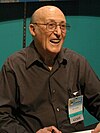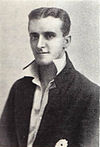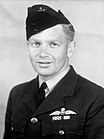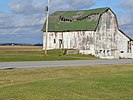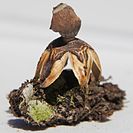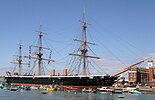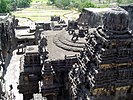Wikipedia:Today's featured article/December 2015
| << | Today's featured articles for December 2015 | >> | ||||
|---|---|---|---|---|---|---|
| Su | Mo | Tu | We | Th | Fr | Sa |
| 1 | 2 | 3 | 4 | 5 | ||
| 6 | 7 | 8 | 9 | 10 | 11 | 12 |
| 13 | 14 | 15 | 16 | 17 | 18 | 19 |
| 20 | 21 | 22 | 23 | 24 | 25 | 26 |
| 27 | 28 | 29 | 30 | 31 | ||
December 1
St Denys' Church is an Anglican parish church in the English market town of Sleaford. Churches have existed on the site since at least 1086, but the date of the present building's construction is unknown. The oldest parts are the tower and spire, which date back to the late 12th and early 13th centuries; the stone broach spire is one of the earliest examples of its kind in England. The Decorated Gothic nave, aisles and north transept were built in the 14th century. A new north aisle was added by the local builders Kirk and Parry in 1853, and the tower and spire were largely rebuilt in 1884 after being struck by lightning. Built out of Ancaster stone with a lead roof, St Denys' is furnished with a medieval rood screen and a communion rail, possibly by Sir Christopher Wren, and has a peal of eight bells, dating to 1796. It houses several memorials, including two altar tombs for members of the Carre family, Sleaford's Lords of the Manor. A Grade I listed building, it is "remembered for the flowing tracery of its windows" according to the architectural historian Sir Nikolaus Pevsner. Worship services are still held at St Denys'. (Full article...)
December 2

Boroughitis was a political phenomenon in the American state of New Jersey in the 1890s, particularly in Bergen County. Attempts by the New Jersey Legislature to reform local government and the school systems led to the formation of dozens of low-population boroughs. In the late 19th century, much of New Jersey was divided into large townships, in which there might be several small communities, each with a local school that formed its own district. Political disputes arose between the growing number of commuters, who wanted more government services, and farmers, who feared higher taxes. In 1894, the legislature passed an act allowing boroughs that were formed from parts of two or more townships to elect a representative to the county Board of Chosen Freeholders. This law, in combination with a second one the same year that consolidated the school districts into one per township, made it easy and attractive for dissatisfied communities to break away and become boroughs. Forty new boroughs were formed in 1894 and 1895, with the bulk in Bergen County, where townships were broken up or greatly reduced in size; few townships remain in the county today. (Full article...)
December 3
The Lafayette dollar was an American silver coin issued to raise money for a statue of Lafayette, a French aristocrat and military officer who fought for the United States in the American Revolution. The statue was dedicated at the Paris World's Fair of 1900. President William McKinley chose Chicago businessman Ferdinand Peck as commissioner-general for the American exhibit at the Paris exposition, and Peck approved the monument for the exhibit. The coin was designed by the Mint's Chief Engraver, Charles E. Barber, and features conjoined busts of George Washington and Lafayette on the obverse. The images are based on a sculpture of Washington by Jean-Antoine Houdon and a medal of Lafayette by François-Augustin Caunois. The reverse depicts an early sketch of the planned monument. All the coins were struck at the Philadelphia Mint on December 14, 1899, the centennial of Washington's death. They did not sell out, and 14,000 were later melted by the Treasury. The coins are valued from several hundred dollars to tens of thousands, depending on condition. The Lafayette dollar was the only U.S. silver dollar commemorative prior to 1983, and the first U.S. coin to depict an American citizen. (Full article...)
December 4
Mary Celeste was an American merchant brigantine. On December 4, 1872, en route to Genoa from New York, the ship was discovered abandoned and deserted off the Azores Islands in a disheveled but seaworthy condition, with no obvious signs of sudden catastrophe. The final entry in the log, dated ten days previously, was a routine statement of the ship's position. There were ample provisions on board, and the cargo was intact. None of those who had been on board were seen or heard from again. At the subsequent salvage hearings in Gibraltar the court's officers found no evidence of conspiracy or foul play. Over time the story has been distorted by false detail and fanciful explanations, including attacks by giant squid and paranormal intervention. The mystery has been recounted and dramatized in documentaries, novels, plays and films, and the name of the ship has become synonymous with unexplained desertion. After the Gibraltar hearings, Mary Celeste continued in service under new owners until, in 1885, the ship was wrecked off the coast of Haiti in an attempted insurance fraud. (Full article...)
December 5
The Battle of Sio, fought between December 1943 and March 1944, was the break-out and pursuit phase of General Douglas MacArthur's Huon Peninsula campaign, part of the New Guinea campaign of World War II. Following the defeat of the Japanese in the Battle of Sattelberg, Australian Army forces broke through positions around Finschhafen. Constant pressure from US Navy PT boats, Australian land forces and Allied aircraft brought the Japanese logistical system to the brink of collapse, resulting in disease, malnutrition and privation for the Japanese soldiers. Australian and Papuan troops advanced along the coast, employing infantry, tanks, and air strikes against the Japanese positions, which were generally sited at creek crossings in the jungle. The Australian and Papuan troops inflicted heavy and disproportionate casualties on the Japanese as they advanced, ultimately linking up with the American forces at Saidor. Australian troops were also able to capture important Japanese cryptographic materials. Hundreds of Japanese soldiers were killed; thousands more died from disease, malnutrition, exhaustion and suicide. (Full article...)
December 6
A Contract with God is a 1978 graphic novel by American cartoonist Will Eisner (pictured). It is a short story cycle focusing on poor Jewish characters who live in a tenement in New York City. In the lead story, a religious man gives up his faith after the death of his young adopted daughter. The four stories in the novel are thematically linked with motifs of frustration, disillusionment, violence, and ethnic identity. Eisner uses large, monochromatic images in dramatic perspective, and emphasizes caricatured facial expressions. Few panels or captions have traditional borders. The small press Baronet Books released A Contract with God in 1978 and marketed it as a "graphic novel", which then became the common term for book-length comics. It sold slowly at first, but gained respect from Eisner's peers, and has since been reprinted by larger publishers. Eisner produced two sequels set in the same tenement: A Life Force in 1988, and Dropsie Avenue in 1995. A Contract with God cemented Eisner's reputation as an elder statesman of comics, and he continued to produce graphic novels and theoretical works on comics until his death in 2005. (Full article...)
December 7
George Macaulay (1897–1940) played first-class cricket professionally for Yorkshire County Cricket Club between 1920 and 1935. He played in eight Test matches for England from 1923 to 1933, achieving the rare feat of taking a wicket with his first ball in Test cricket. One of the five Wisden Cricketers of the Year in 1924, he took 1,838 first-class wickets at an average of 17.64, including four hat-tricks. He was a leading member of his successful Yorkshire team and a volatile character who played aggressively. He left a job at a bank to become a professional cricketer, making his first-class debut aged 23 as a fast bowler, but he had more success after altering his style to include off spin. He played fewer Test matches after an unsuccessful match in the 1926 Ashes series. His form slumped following injuries in the late 1920s, but a recovery in the early 1930s led to a recall by England. His first-class career ended in 1935, although he continued playing club cricket until the Second World War. A pilot officer in the Royal Air Force, he died of illness on active service. (Full article...)
December 8
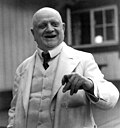
The Eighth Symphony was Jean Sibelius's final major compositional project, occupying him intermittently from the mid-1920s until around 1938. How much of the symphony was completed is unknown; Sibelius repeatedly refused to release it for performance, though he promised the premiere to several leading conductors. Following the success of his Seventh Symphony of 1924, it was expected that his symphonic flow would continue, but after the tone poem Tapiola of 1926, his published output was confined to minor pieces and revisions to earlier works. The Eighth Symphony's destruction was made known after Sibelius's death in 1957, but in the 1990s, while cataloguing the composer's many notebooks and sketches, scholars speculated that fragments of music from the lost symphony may have survived. Several short manuscript sketches have been tentatively identified with the Eighth, three of which (comprising less than three minutes of music) were recorded by the Helsinki Philharmonic Orchestra in 2011. The prospect of further reconstruction has generally been discounted; the propriety of publicly performing music that Sibelius himself had rejected has also been questioned. (Full article...)
December 9
Infinity Blade is a fighting game developed by Chair Entertainment and Epic Games and released through the App Store on December 9, 2010. It is the first iOS video game to run on the Unreal Engine. In the game, the unnamed player character fights a series of one-on-one battles in a derelict castle to face the immortal God King. When in battle, players swipe the screen to attack and parry, and tap the screen to dodge and block enemy attacks. Upon victory or defeat, the player restarts the game as the character's descendant with the same items and experience level. Developed by a team of twelve people, the game was intended to demonstrate the new iOS version of the Unreal Engine. Four free expansions added new equipment, endings, and game modes. The game made US$1.6 million in the first four days after its release, more than any other app in the history of iOS, and over $23 million by the end of 2011. Reviews heavily praised the graphics and compared the mobile game favorably to console games. Critics also praised the swipe-based combat system, but split opinions on the cyclical gameplay as either addictive or repetitive. (Full article...)
December 10
Nicky Barr (1915–2006) was a member of the Australian national rugby union team who became a fighter ace in the Royal Australian Air Force (RAAF) during World War II. Selected to play for Australia on a tour of the United Kingdom in 1939, he had just arrived in England when war broke out and the tour was cancelled. He joined the RAAF in 1940 and was posted to North Africa with No. 3 Squadron in September 1941. Barr's achievements as a combat pilot earned him the Distinguished Flying Cross and Bar. Shortly after taking command of No. 3 Squadron in May 1942, he was shot down and captured by Axis forces, and incarcerated in Italy. He escaped and assisted other Allied fugitives to safety, receiving for his efforts the Military Cross, a rare honour for an RAAF pilot. Repatriated to England in 1944, he saw action during the invasion of Normandy before returning to Australia as chief instructor with No. 2 Operational Training Unit. He rejoined the RAAF as an active reserve officer from 1951 to 1953. After his subsequent success for many years in the oilseed industry, he was appointed an Officer of the Order of the British Empire in 1983. (Full article...)
December 11
The pallid sturgeon (Scaphirhynchus albus) is an endangered species of ray-finned fish, endemic to the waters of the Missouri and lower Mississippi River basins of the United States. Named for its pale coloration, it is related to the much smaller shovelnose sturgeon (S. platorhynchus). When mature at 15 years, individuals average 85 pounds (39 kg) and 30 to 60 inches long (76 to 152 cm). The fish spawns infrequently over its lifespan of up to a century. This sturgeon species has remained virtually unchanged since it coexisted with the Cretaceous dinosaurs 70 million years ago. In 1990, the pallid sturgeon became the first Missouri River basin fish on the U.S. Fish and Wildlife Service's endangered species list, after sightings had greatly diminished. Loss of habitat is thought to be responsible for its decline; much of the Missouri River drainage system has been channeled and dammed, reducing the gravel deposits and slow-moving side channels that are its favored spawning areas. In an effort to save the species from extinction, pallid sturgeon are being raised in a dozen hatcheries and released back into the wild. (Full article...)
December 12
The Far Eastern Party of the Australasian Antarctic Expedition set out with sled dogs in November 1912 to collect specimens, map the coast, and claim territory. Douglas Mawson (pictured), Belgrave Ninnis and Xavier Mertz had covered 311 miles (501 km) when Ninnis and a sled broke through the snow lid of a crevasse and were lost. With few supplies left, Mawson and Mertz made for the main base at Cape Denison, eating the remaining sled dogs one by one. Mertz became sick, and died within a week. For almost a month, Mawson pulled his sled alone across snow and ice despite an illness that increasingly weakened him. He reached the comparative safety of Aladdin's Cave—a food depot 5.5 miles (8.9 km) from the main base—on 1 February, only to be trapped there for a week while a blizzard raged outside. He arrived at the main base just hours after the expedition ship, SY Aurora, sailed for Australia, fleeing the encroaching ice. With a relief party, Mawson remained at Cape Denison until the ship returned the next summer, 10 months later. In 1976 Sir Edmund Hillary described Mawson's journey as "probably the greatest story of lone survival in Polar exploration". (Full article...)
December 13
American rock musician Jimi Hendrix was charged with drug possession in Canada in May 1969. Customs agents at Toronto International Airport detained Hendrix (pictured) after finding a small amount of heroin and hashish in his luggage. Released on $10,000 bail, he performed at Maple Leaf Gardens later that night, joking with the crowd. In December he stood trial for two counts of illegal possession of narcotics, carrying a maximum sentence of 20 years in prison. Judge Joseph Kelly presided. Defense attorney John O'Driscoll raised doubts about whether the narcotics belonged to Hendrix, who had no drug paraphernalia in his luggage or needle tracks on his arms, and whether he even knew they were in his luggage. He was acquitted after a three-day trial. Both of Hendrix's bandmates in the Jimi Hendrix Experience, Mitch Mitchell and Noel Redding, later said that they had been warned about a planned drug bust the day before flying to Toronto and that they believed the drugs had been planted in his bag. Hendrix was the world's highest-paid performer when he was arrested, but this was his last tour, and he died the following year. (Full article...)
December 14
The Toledo War (1835–36) was a nearly bloodless sovereignty dispute between the US state of Ohio and the Michigan Territory over a small strip of land along their border, fueled by conflicting legislation, a desire to control the then-prosperous city of Toledo, and poor maps. After Ohio politicians blocked Michigan's bid to become a state, both sides raised militias to enforce their claims. The only casualty was a wounded sheriff, stabbed with a penknife, and in the only clash, Michigan militiamen fired shots in the air and captured Ohioan surveyors. After President Andrew Jackson intervened to keep Ohio's support for his fledgling Democratic Party, Michigan agreed at what is now called the Frostbitten Convention to a compromise. The strip was sacrificed in exchange for statehood and the undeveloped Upper Peninsula, which would later produce an economic windfall in timber, iron, and copper. Vestiges of the dispute persisted for 137 years and were ended only with the help of the US Supreme Court in 1973. Memories of the Toledo War helped ignite the Michigan–Ohio State football rivalry. (Full article...)
December 15
Ununseptium is the current name of the artificial chemical element with atomic number 117. The second-heaviest known element and second-to-last element of the 7th period of the periodic table, its discovery was announced in Dubna, Russia, by a Russian–American collaboration in 2010, making it the most recently discovered element. One of its daughter isotopes was created in 2011, partially confirming the results. The experiment was repeated successfully by the same collaboration in 2012 and by a joint German–American team in 2014. When these experiments have been examined and verified by the Joint Working Party, the discoverers will be invited to give the element an official name. Some of ununseptium's isotopes are expected to lie within the island of stability, a predicted group of nuclides of enhanced stability with atomic numbers around 120, but the isotopes of ununseptium created so far have had predicted half-lives of less than one second. Like fluorine, chlorine, and other halogens, ununseptium is expected to be a group 17 element, but it is not currently expected to be a halogen, as some of its properties are likely to be different due to relativistic effects. (Full article...)
December 16
Geastrum quadrifidum, commonly known as the rayed earthstar, is an inedible species of mushroom belonging to the genus Geastrum, the earthstar fungi. First described by Christian Hendrik Persoon in 1794, it is a cosmopolitan but uncommon species found in Europe, the Americas, Africa, Asia, and Australasia. The fungus feeds off decomposing organic matter in the litter and soil of coniferous forests. The small, grayish-brown fruit bodies are enclosed by a skin, or peridium, made up of four layers of tissue. The outer layer splits to form star-like rays and expose a spore case, inside of which is the gleba—fertile spore-producing tissue. The spore case, set on a short, slender stalk, has a well-defined narrow pore at the top through which mature spores escape. The mushroom's outer skin is purplish-brown, with four or five cream or yellowish-brown rays whose tips are stuck in the substrate. This species is one of several earthstars whose rays arch downward as they mature, lifting the spore sac upward and allowing it to catch air currents that disseminate the spores. (Full article...)
December 17
Harry Glicken (1958–1991) was an American volcanologist who researched Mount St. Helens before and after its dramatic eruption in 1980. Despite a long-term interest in working for the U.S. Geological Survey, Glicken never received a permanent post there because employees found him eccentric. Conducting independent research sponsored by the National Science Foundation and other organizations, Glicken accrued expertise in the field of volcanic debris avalanches. He wrote several major publications on the topic, including his doctoral dissertation on Mount St. Helens. In 1991, while conducting avalanche research with volcanologists Katia and Maurice Krafft on Mount Unzen in Japan, Glicken was killed by a wayward pyroclastic flow. Glicken and David A. Johnston (who died at Mount St. Helens) remain the only American volcanologists known to have perished in volcanic eruptions. After Glicken's dissertation was published by his colleagues in 1996, the report was widely cited. His detailed and comprehensive work on flows at Mount St. Helens is considered the most complete in the field to date. (Full article...)
December 18
Interstate 496 (I-496) is an auxiliary Interstate Highway that passes through downtown Lansing in the US state of Michigan. Also a component of the State Trunkline Highway System, the loop route runs east from I-96 to the downtown area, turning south concurrently with US Highway 127. It passes a former assembly plant used by Oldsmobile and runs along or crosses parts of the Grand and Red Cedar rivers. Construction started in 1963, and the freeway opened on December 18, 1970. Segments south of downtown were built near a historically black neighborhood that dates from the early 20th century. Community leaders opted not to fight the construction of the freeway, instead seeking affordable housing and relocation assistance for displaced residents. The city named the freeway in honor of a former mayor when it opened in 1970, but the local historical society proposed that the state rename it after Ransom E. Olds, the founder of Oldsmobile and the REO Motor Car Company, after his mansion was demolished to make way for the freeway. The Michigan Legislature approved the name "Olds Freeway" two years later. (Full article...)
Part of the Interstate 96 featured topic.
December 19
Robert de Chesney was a medieval English Bishop of Lincoln. Educated at Oxford or Paris, Chesney was Archdeacon of Leicester before his election as bishop in December 1148. He served as a royal justice in Lincolnshire, and was an early patron of Thomas Becket. Although shown favour by King Stephen of England, including the right to a mint, Chesney was present at the coronation of King Henry II of England in 1154 and went on to serve Henry as a royal justice. In about 1160 Chesney became embroiled in a dispute with St Albans Abbey that was eventually settled when the abbey granted him land in return for his relinquishing any right to oversee the abbey. He was active in his diocese; more than 240 documents relating to his episcopal career survive. They show him mediating disputes between religious houses and granting exemptions and rights in his diocese. Chesney bought a house in London to serve as an episcopal residence, constructed an episcopal palace in Lincoln, and founded a religious house outside the city. He died in December 1166 and was buried in Lincoln Cathedral. (Full article...)
December 20
The Wrestlers is an oil painting by English artist William Etty, painted around 1840 in the life class of the Royal Academy. It depicts a wrestling match between a black man and a white man, both glistening with sweat and under an intense light that emphasises their musculature. Etty was best known for his paintings of nude or near-nude women in historical and mythological settings but had also painted men involved in various forms of combat. At that time, sports were becoming increasingly popular, and the painting is both a reflection of this trend and a part of the English tradition of copying poses from classical Hellenistic works. It was also a time of change in the British attitude to race relations. In this period Etty often made a conscious effort to illustrate moral lessons in his work, and it is not clear whether he chose the topic as a form of social commentary or simply because the contrast between the dark and pale flesh tones was visually striking. The Wrestlers, as part of a private collection, was not seen publicly from about 1849 until 1947, when it was put on sale and purchased by the York Art Gallery, where it remains. (Full article...)
December 21
Benjamin Disraeli (1804–1881) was a British politician and writer who twice served as prime minister. He played a central role in the creation of the modern Conservative Party, defining its policies and its broad outreach. Disraeli entered the House of Commons in 1837. In 1846, after clashing with the Prime Minister, Sir Robert Peel, Disraeli became a major figure in the party, though many in it did not favour him. He served as Chancellor of the Exchequer and Leader of the House of Commons in the 1850s and 1860s, and became prime minister briefly in 1868 before losing that year's election. In his second term as prime minister (1874–80), he arranged Britain's purchase of a major interest in the Suez Canal Company, and worked at the Congress of Berlin to maintain peace in the Balkans and to make terms that favoured Britain and weakened Russia. He had throughout his career written novels, and he published his last completed one, Endymion, shortly before he died. Disraeli is remembered for his influential voice in world affairs, his political battles with the Liberal leader William Ewart Gladstone, and his one-nation conservatism or "Tory democracy". (Full article...)
December 22
Miniopterus aelleni is a bat in the genus Miniopterus found in the Comoro Islands and Madagascar. It is a small, brown bat, with a forearm length of 35 to 41 mm (1.4 to 1.6 in). The long tragus (a projection in the outer ear) has a broad base and a blunt or rounded tip. The uropatagium (tail membrane) is sparsely haired. The palate is flat and there are distinct diastemata (gaps) between the upper canines and premolars. Populations of this species were previously included in Miniopterus manavi, but recent molecular studies revealed that M. aelleni is a separate species and that Miniopterus is more species-rich than previously thought. M. aelleni is known to live from 4 to 225 m (13 to 738 ft) above sea level in northern and western Madagascar, at 1,100 m (3,600 ft) in northern Madagascar, and from 220 to 690 m (720 to 2,260 ft) on Anjouan in the nearby Comoros. On Madagascar, M. aelleni has been found in forests and caves in karstic areas. The specific name aelleni honors Professor Villy Aellen of the Natural History Museum of Geneva. (Full article...)
December 23
Tropical Storm Edouard was the first of eight named storms to form in September 2002, the most such storms for any month in the Atlantic at the time. The fifth tropical storm of the 2002 Atlantic hurricane season, Edouard developed into a tropical cyclone on September 1 from an area of convection associated with a cold front east of Florida. Under weak steering currents, Edouard drifted to the north and executed a clockwise loop to the west. Despite moderate to strong levels of wind shear, the storm reached a peak intensity of 65 mph (100 km/h) on September 3, but quickly weakened as it tracked westward. Edouard made landfall in northeastern Florida two days later, and dissipated the next day after crossing the state. The storm dropped moderate rainfall across Florida, exceeding 7 inches (175 mm) in the western portion of the state. Though Edouard was a tropical storm at landfall, wind speeds along the storm's path over land were light. The rain flooded several roads, but there were no casualties, and damage was minimal. The storm was eventually absorbed into the larger circulation of Tropical Storm Fay. (Full article...)
Part of the 2002 Atlantic hurricane season featured topic.
December 24
William Wurtenburg (1863–1957) was an American college football player and coach. Born to German parents and raised in western New York, Wurtenburg played for Phillips Exeter Academy and Yale University. The 1887 Yale squad outscored their opponents 515–12, and the 1888 squad, which he quarterbacked, held all opponents scoreless; both teams were later recognized as national champions. Wurtenburg received his medical degree from Yale's Sheffield Scientific School in 1893. He coached football for a year at the United States Naval Academy and then for five years at Dartmouth College. In his first four years at Dartmouth, the teams had perfect records against both of their Triangular Football League opponents. Wurtenburg spent several years refereeing for Yale's football team, then had a practice as an ear, nose and throat specialist in New Haven, Connecticut, from 1904 until at least 1920. He is particularly remembered for a 35-yard run in a close game in 1887 against rival Harvard, a game that was described as "undoubtedly the finest ever played in America". (Full article...)
December 25
"Sisters at Heart" is the 13th episode of the seventh season of Bewitched, an American Broadcasting Company fantasy television sitcom. This Christmas episode aired on December 24, 1970, and again the following December. In one storyline, Darrin Stephens (Dick Sargent) fails to land a million-dollar advertising account after a toy company owner mistakes a black woman for Darrin's wife. The man changes his attitude after Samantha Stephens (Elizabeth Montgomery) uses witchcraft to make him see everyone, including himself, as having black skin. At the invitation of Montgomery and her husband William Asher, who directed the episode, "Sisters at Heart" was initially written by 22 black students from Jefferson High School (pictured), a school in a poor Los Angeles neighborhood. This episode, Montgomery's favorite, received the Governors Award at the 23rd Primetime Emmy Awards. Montgomery's biographer Herbie Pilato wrote that the theme of overcoming prejudice is central to Bewitched and that "no [other] episode of the series more clearly represented this cry against prejudice". (Full article...)
December 26
Andrew Johnston (born 1994) is a British singer who rose to fame when he appeared as a boy soprano on the second series of the British television talent show Britain's Got Talent in 2008. He sang "Pie Jesu" from Andrew Lloyd Webber's Requiem in the finals. Although he did not win, he received a contract to record on the SyCo Music label owned by the Britain's Got Talent judge Simon Cowell. Johnston's debut album, One Voice, was released in September of the same year, and reached number four on the UK Albums Chart. Johnston was born in Dumfries, Scotland, and grew up in Carlisle. He became head chorister at Carlisle Cathedral, and was bullied at school for his love of classical music. While some journalists have argued that Britain's Got Talent producers exaggerated Johnston's rough background, others have hailed his story as inspirational. In 2009, he graduated from Trinity School. He sings in the National Youth Choir as a baritone and studies full-time at the Royal Northern College of Music. (Full article...)
December 27
Kent is the largest city in Portage County in the U.S. state of Ohio. It is part of the Akron Metropolitan Statistical Area and the larger Cleveland–Akron–Canton Combined Statistical Area. The population was 28,904 in the 2010 Census and slightly higher in the 2014 estimate. Part of the Connecticut Western Reserve, it was settled in 1805 as a mill town along the Cuyahoga River and later named Franklin Mills. In the 1830s and 1840s, the village was on the route of the Pennsylvania and Ohio Canal. Franklin Mills was an active stop on the Underground Railroad before the Civil War. The city was renamed in 1864 for Marvin Kent, who secured the maintenance yards of the Atlantic and Great Western Railroad (depot pictured) for Franklin Mills. Today Kent is a college town best known as the home of the main campus of Kent State University, founded in 1910, and as the site of the 1970 Kent State shootings. While historically a manufacturing center, the city's largest economic sector is now education. Many Kentites and Kent State alumni have risen to prominence in business, sports, and the arts. (Full article...)
December 28
Kingdom Hearts II is an action role-playing game developed and published by Square Enix in 2005 for the PlayStation 2 video game console. The game is a sequel to the 2002 Disney Interactive and Square collaboration, Kingdom Hearts, and to Kingdom Hearts: Chain of Memories. In this game, the protagonist Sora returns to search for his lost friends, while Organization XIII from Chain of Memories reappears to impede his progress. All three games feature a large cast of characters from Disney films and Final Fantasy games. The game was well-received, earning year-end awards from numerous video gaming websites. In Japan, it shipped more than one million copies within a week of its release. One month after its North American release, it had sold over one million copies. By March 31, 2007, the game had shipped over 4 million copies worldwide. A novel and manga series are based on it, as well as an international version called Kingdom Hearts II Final Mix, re-released in high definition as Kingdom Hearts HD 2.5 Remix for the PlayStation 3. The game was actor Pat Morita's final voice role before his death in 2005. (Full article...)
December 29
HMS Warrior was the name ship of a class of two 40-gun steam-powered armoured frigates built for the Royal Navy in 1859–61. The sister ships Warrior and HMS Black Prince were the first armour-plated, iron-hulled warships, and were built in response to France's launching in 1859 of the first ocean-going ironclad warship, the wooden-hulled Gloire. After a publicity tour of Great Britain in 1863, Warrior had an active career with the Channel Squadron. The frigate became obsolescent following the 1871 launching of the mastless and more capable HMS Devastation, was placed in reserve in 1875, and was decommissioned in 1883. After serving as a storeship and depot ship, Warrior was assigned in 1904 to the Royal Navy's torpedo training school. The frigate was converted into an oil jetty in 1927 and was donated by the Navy to the Maritime Trust for restoration in 1979. The restoration process took eight years, during which many of the ship's features and fittings were either restored or recreated. When this was finished Warrior returned to Portsmouth as a museum ship. Listed as part of the National Historic Fleet, the ship has been based in Portsmouth since 1987. (Full article...)
December 30
The Rashtrakuta dynasty ruled large parts of the Indian subcontinent between the sixth and tenth centuries. Early Rashtrakuta inscriptions show their clans ruling from Manapura, a city somewhere in Central or West India, and from modern-day Kannauj in Uttar Pradesh and Elichpur in Maharashtra. This third clan overthrew Kirtivarman II and built an empire as the Rashtrakutas of Manyakheta, rising to power in South India in 753. At the same time the Pala dynasty of Bengal (in eastern India) and the Prathihara dynasty of Malwa (in the northwest) were gaining force. Each of these three empires annexed the seat of power at Kannauj for short periods of time while struggling for the resources of the rich Gangetic plains. At their peak the Rashtrakutas of Manyakheta ruled a domain stretching from the confluence of the Ganges and Yamuna rivers in the north to Cape Comorin in the south. The early kings of this dynasty were Hindu, while the later kings were strongly influenced by Jainism. The empire was known for its literary and architectural achievements, including the Kailasanath Temple at Ellora (pictured) and the Jain Narayana temple at Pattadakal, both UNESCO World Heritage Sites. (Full article...)
December 31
Steve Bruce (born 1960) is an English football manager, currently for Hull City, and a former player. A defender, he began his professional career at Gillingham in 1979, and made over 200 appearances before transferring to Norwich City five years later. From 1987 to 1996, he played for Manchester United, winning the Premier League, FA Cup, Football League Cup and European Cup Winners' Cup. He was the first English player of the twentieth century to captain a team to the Double. Bruce began his managerial career with Sheffield United, and briefly managed Huddersfield Town, Wigan Athletic and Crystal Palace. He joined Birmingham City in 2001 and twice led them to promotion to the Premier League during his tenure of nearly six years, but resigned in 2007 to begin a second spell as manager of Wigan. At the end of the 2008–09 season he resigned to take over as manager of Sunderland, a post he held until he was dismissed in November 2011. Seven months later, he was appointed manager of Hull City, and has since led the club to promotion to the Premier League and the 2014 FA Cup Final. (Full article...)





